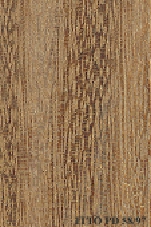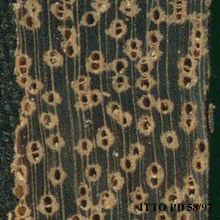
SUCUPIRA PRETA (Diplotropis martiusii)
Trade Name
Sucupira Preta
Scientific Name
Diplotropis martiusii Benth.
Family
LEGUMINOSAE
Common Names
Sucupira-Parda (Brazil); Chontaquiro (Peru)
Scientific Name Synonyms
Dibrachion riparium Spruce ex Benth.; Bowdichia martiusii (Benth.) Ducke
Description Of The Tree
Botanical Description
This tree is reported to be of medium size, attaining heights of 20 m in the average. The boles are clear to lengths of about 14 m, with diameters between 60 to 70 cm.
Natural Habitat
Diplotropis martiusii is widespread in tropical South America. It prefers non-inundable areas in primary and secondary forests.
Natural Distribution
The species is reported to occur in northern tropical South America, down to Peru. In Peru it is reported in Yurimaguas, Tamishiyacu, Requena and Pucallpa.
Wood Identification
Anatomic Description Of Wood
Wood diffuse porous. Vessels solitary and in short radial multiples. Occasionally tangential diameter of vessel lumina 200 micras or more. Occasionally white deposits in heartwood vessels. Occasionally vessels per mm2 less than 6. Simple perforation plates. Ves Occasionally axial parenchyma in marginal or in seemingly marginal bands. Axial parenchyma lozenge-aliform. Axial parenchyma confluent. Occasionally prismatic crystals in chambered axial parenchyma cells and/or in fibers. 3 to 4 cells per parenchyma strand. 4 to 10 rays per mm (medium). Rays 1 to 4 seriate. Occasionally heterogeneous rays and/or multiseriate heterogeneous rays. Body ray cells procumbent with mostly 2 to 4 rows of upright and/or square marginal cells (Kribs-II). Fibers with simple to minutely bordered pits.
-
 Wood Macro Photo Radial Plane
Wood Macro Photo Radial Plane
-
 Wood Micro Photo Of Transversal Section
Wood Micro Photo Of Transversal Section
Availability
Cites Status
Unrestricted
General Wood Description
Odor
Odor and taste are reported to be indistinct.
Color
The sapwood is differentiated. The heartwood is dark brown to chocolate brown in color.
COLOR INDEX (1=Black, 7=Light yellow,white)
4
Grain
Grain is reported to be typically interlocked, producing a very fine silver figure.
Texture
The wood is coarse-textured.
Natural Durability
It is very durable against decay and insects attack.
Natural durability index (1= Very high durability, 7=Vey low durability)
1
Silica Content
Silica Content: A negligible content of 0.04 % of silica is reported. Silica Value: 0.04
Resistance To Impregnation
This timber responds poorly to preservative treatment.
Wood Physical Properties
Basic Density or Specific Gravity (O.D. weight/vol. green) (g/cm³)
0.81
Air-dry Density (Weight and volume at 12%MC) (g/cm³)
0.93
Total shrinkage Tangential (Saturated to 0%MC) (%)
6.1
Total shrinkage Radial (Saturated to 0%MC) (%)
4.1
Drying Defects
Ease of Drying: Drying is reported as moderately rapid. Drying Defects: Risk of checking, cupping and twisting. Casehardening is also reported.
Dimensional stability ratio (Total Tangential Shrinkage %/Total Radial Shrinkage %)
1.5
Wood Chemical Properties
Wood Mechanical Properties
Workability
Sawing
Sawing of this species is easy. Stellite tipped band saws are recommended.
Rotary Veneer Cutting
The timber is reported to be suitable for slicing into decorative veneers.
Sliced Veneer
The timber is reported to be suitable for slicing into decorative veneers.
Blunting Effect
The wood is reported to have moderate dulling effect on cutting edges.
Planing
Sucupira is hard and typically contains interlocked grain, factors which are reported to combine to make it a rather difficult wood to plane and work in most woodworking operations.
Moulding
Molding operations are rated as fair.
Turning
30
Boring
Boring operations are fair.
Nailing
The wood is difficult to nail, and requires pre-boring.
Finishing
The wood is reported to finish well after filling.
REFERENCED USES
End Uses Summary
EXTERIOR GENERAL, bridges, poles, paling, stakes posts, rails, crossarms, crossties, HOUSING GENERAL, beams, joists, boards, flooring, frames, steps, FURNITURE AND CABINETS, PLYWOOD AND VENEER, Decorative veneer, TURNING, ornaments, turned furniture, cutlery, TOOLS, tool handles, agricultural tools, CONTAINERS, truck bodies, truck flooring, NAVAL CONSTRUCTION, boat deck, OTHER AND MUSICAL INSTRUMENTS, yoke
Exterior General
- 1 - Tabela de resultados de ensaios fisicos e mecanicos
Bridges
- 2 - 25 madeiras da amazonia de valor comercial, caracterizacao, macroscopica, usos comuns e indices qualificativos
Poles
- 3 - Estudo dendrologico e determinacao das caracteristicas fisicas e mecanicas do genipapo (Genipa americana)
Paling Fence Pickets
- 4 - Estudo dendrologico e determinacao das caracteristicas fisicas e mecanicas da bicuiba
Stake Posts
- 5 - Propriedades fisicas e mecanicas da madeira e do contraplacado de Pinus elliottii
Rails
- 6 - Physical and mechanical properties of Eucalyptus deglupta Blume grown in Costa Rica
Crossheads Crossarms
- 7 - Maderas latinoamericanas. II, Quercus alata Q. costaricensis y Q. eugeniaefolia
Crossties
- 8 - Maderas latinoamericas. III, Podocarpus standleyi ,Podocarpus oleifolius, Drims granadensis, Magnolia poasana y Didymopanax pittieri
General Housing
- 10 - Silica in Timbers
Beams
- 11 - Prospect: The wood database
Joists
- 12 - Tropical timbers of the world. Part I-Tropical American Species
Boards
- 13 - Dry kiln schedules for commercial woods. Temperate and tropical. Section III. Latin American (Mexico, Central, and South America) Woods–Conventional Temperatures
Flooring
- 14 - Handbook of Hardwoods
Frames
- 16 - Woods of the World
Steps
- 17 - Tree Conservation Database
Furniture Cabinets
- 21 - Tropical timbers of the world. Part III-Southeast Asian and Oceanian Species.
Panels, Veneers
- 25 - Directory of Timber Trade Malaysia
Decorative veneer
- 28 - Ministry of Agriculture, Fisheries & Forest of Fiji
Turning
- 30 - Embassy of Honduras in Japan
Ornaments
- 31 - Embassy of Colombia in Japan
Turned Articles
- 32 - Embassy of Cote d`Ivoire in Japan
Knife Handles
- 33 - Embassy of Gabon in Japan
Tools
- 42 - Utilización Industrial de Nuevas Especies Forestales en el Perú.
Tool Handles
- 43 - Maderas de Bolivia (Características y Usos de 55 Maderas Tropicales)
Agricultural Tools
- 44 - Atlas of Peruvian Woods
Truck Body
- 53 - Timbers of the New World
Truck Flooring
- 54 - Bulletin of the Government Forest Experiment Station N.157: Identification of Tropical Woods
Shipbuilding
- 55 - Tropical Timber Atlas of Latin America
Boat Decking
- 59 - Programa Nacional de uso Sostenible de los Bosques e Incremento a las Exportaciones.
Yokes
- 74 - World Timbers, Vol.2, North and South America
Please Provide Information To View Producer Information